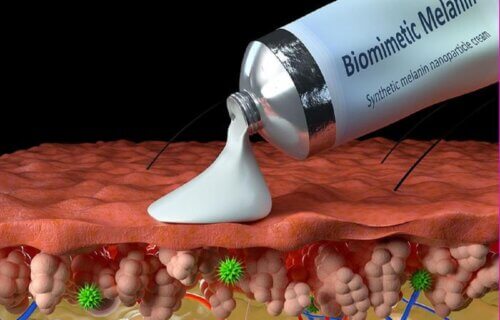EVANSTON, Ill. — A “super melanin” miracle skin cream has the ability to continuously heal sunburn and chemical burns, according to a new study. This synthetic cream offers two major benefits: it shields the skin while mending damage and hastening recovery.
Remarkably non-toxic and transparent, the cream also shows promise as a future treatment for cancer patients enduring radiotherapy, due to its regenerative properties. The groundbreaking research is slated to transform skincare treatments in the near future.
The team at Northwestern University created the cream by replicating human skin’s natural melanin, which imbues skin, eyes, and hair with color and guards against sun damage by darkening the skin, a process known as tanning.
Applied to compromised skin, the synthetic melanin cream accelerates the healing process, safeguarding against sun exposure and ameliorating sun or chemical burn injuries. It operates by corralling “free radicals” — unstable molecules with unpaired electrons, generated by skin when injured, such as by sunburn.
Naturally, melanin neutralizes free radicals, which can be prolific due to environmental pollutants like industrial emissions and car exhaust. If unchecked, these radicals can damage skin cells, potentially leading to skin cancer or premature aging.

“People don’t think of their everyday life as an injury to their skin. If you walk barefaced every day in the sun, you suffer a low-grade, constant bombardment of ultraviolet light. This is worsened during peak mid-day hours and the summer season. We know sun-exposed skin ages versus skin protected by clothing, which doesn’t show age nearly as much,” says co-author of the study, Dr. Kurt Lu, a Dermatology Professor at Northwestern University’s Feinberg School of Medicine, in a university release. “All those insults to the skin lead to free radicals, which cause inflammation and break down the collagen. That’s one of the reasons older skin looks very different from younger skin.”
The research team enhanced synthetic melanin nanoparticles to more effectively scavenge free radicals.
“It’s like super melanin. It’s biocompatible, degradable, non-toxic, and clear when rubbed onto the skin. In our studies, it acts as an efficient sponge; removing damaging factors and protecting the skin,” says co-author Professor Nathan Gianneschi, a Northwestern University Professor of Chemistry, Materials Science & Engineering, Biomedical Engineering, and Pharmacology.
After nearly a decade of melanin research backed by the United States Department of Defense and the National Institutes of Health, the Northwestern team initially tested their synthetic melanin as sunscreen. They found it not only shielded skin cells from solar damage but also promoted the repair of already damaged skin.
The researchers envision the cream being used as a multi-purpose sunscreen booster for extra protection and as an enhanced moisturizer to encourage skin repair and possibly to aid blisters and sores.
“You could put it on before you go out in the sun and after you have been in the sun,” Dr. Lu suggests. “In both cases, we showed a reduction in skin damage and inflammation. You are protecting the skin and repairing it simultaneously. It’s continuous repair.”

In absorbing harmful free radicals following injury, this potential miracle cream also seems to moderate the immune system. By diminishing destructive inflammation on the surface, the skin can initiate healing instead of worsening the inflammation.
“The epidermis and the upper layers are in communication with the entire body. This means that stabilizing those upper layers can lead to a process of active healing,” adds Dr. Lu, who is a Northwestern Medicine dermatologist.
In a simulated injury test on human skin tissue, the researchers applied their melanin cream after inducing a blistering reaction. The cream prompted an immune response, aided the skin’s own radical scavenging enzymes to recover, and halted the production of inflammatory proteins, leading to significantly enhanced healing rates. Without the cream, the tissue samples continued to blister.
“The treatment has the effect of setting the skin on a cycle of healing and repair, orchestrated by the immune system,” Dr. Lu reports.
The team has also investigated using melanin as a dye for toxin-absorbing clothing, potentially beneficial for military uniforms to absorb nerve gas. Their ongoing work includes clinical trials to test the efficacy of the synthetic melanin cream. Initial trials have confirmed its non-irritating nature to human skin.
Considering the melanin’s protective effects against high-energy radiation, the researchers are hopeful that the cream could be used to treat radiation-induced skin burns and offer new treatment avenues for cancer patients undergoing radiation therapy.
The study is published in the journal Nature npj Regenerative Medicine.
You might also be interested in:
- Best Sunburn Remedies: Top 5 At-Home Treatments Most Recommended By Experts
- Best Skincare Tips For Skin Of Color: Top 5 Guidelines, According To Doctors
- Wound-healing ink from high-tech pen could soon replace bandages
South West News Service writer James Gamble contributed to this report.


Can I buy this cream in UK yet